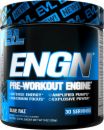
How To Build Your Own Workouts On The Fly!
Use this smart approach to build your workout in a new gym, on vacation, or any time you need a break from strict programming. It can be customized for any goal!
Stop me if you've heard this before: "If you're failing to plan, you're planning to fail."
Look, we all know that the best way to see consistent progress in the gym is to have a set plan in place and to follow a program. You've been told that a million times. You address your weaknesses, continue to build upon your strengths, build balanced strength, and keep moving in the right direction.
But there are certain times when it makes sense to think outside the box. Maybe your training feels stale, and you're tired of doing more or less the same thing over and over again. When this happens, it would be silly to ignore it. Maybe you're tired of being told what to do for each and every rep, and you want a little more room to experiment and explore. This is OK, too!
I've got two plug-and-play templates that will allow you to get into the gym and have a great training session without having to fret over all the little details. I don't recommend these templates as your only program, but they'll work great as a one-day vacation, a one-week adventure, or even a one-month nonprogram program.
Option 1 The 3-Day Total-Body Split
The key to building a great workout on the fly is to ensure that it's not totally random. For example, this template provides plenty of room for interpretation, but at the same time, it covers all the major movement patterns you need for full-body muscular development and strength.

Without further ado, here's your program, along with 3-4 options for each movement variation. If there's something you want to do that isn't listed but fits in the category, you can certainly sub it out.
Monday
- Bilateral squat variation: Back squat, front squat, double-kettlebell front squat
- Push-up variation: Push-up, feet-elevated push-up, weighted push-up, single-arm push-up, band-resisted push-up
- Split-stance variation: Split-squat, reverse lunge, forward lunge
- Row variation: Dumbbell row, chest-supported row, T-bar row
- Core exercise: Your choice
Wednesday
- Compound press: Bench press, incline bench, dumbbell bench, military press
- Supplemental posterior chain: Barbell Romanian deadlift
- Pull-up/chin-up variation: Weighted, unweighted, TRX bodyweight row
- Knee flexion: Glute-ham raise, Nordic hamstring, ball leg curl
- Core exercise: Your choice
Friday
- Deadlift variation: Sumo deadlift, conventional deadlift, trap-bar deadlift
- Accessory press: Floor press, close-grip bench press, dumbbell bench variations
- Single-leg variation: Step-up, Bulgarian split squat, pistol squat, single-leg deadlift
- Gun show: Biceps and triceps exercises of your choice, supersetted
- Core exercise: Your choice
How do you know which exercise variation to choose? Let your goals, intuition, and curiosity guide you. If there's something you've been wanting to try, give it a shot for a few weeks.
If you go to the gym and you can't get the equipment for one variation, try another. Be flexible, but push yourself in whatever you choose.
Option 2 The 4-day upper-lower split
If you've got more time on your hands and are up to the challenge of less recovery time, here's a four-day split you can use to build your workout on the fly.
Monday
- Bilateral squat variation: Back squat, front squat, double-kettlebell front squat
- Supplemental posterior chain: RDL, good morning, or other glute-and-ham builder
- Split-stance variation: Split-squat, reverse lunge, forward lunge
- Knee flexion: Glute-ham raise, Nordic hamstring, ball leg curl
- Core exercise: Your choice
Wednesday
- Compound press: Bench press, incline bench, dumbbell bench, military press
- Pull-up/chin-up variation: Weighted, unweighted, TRX bodyweight row
- Accessory press: Floor press, close-grip bench press, dumbbell bench variations
- Shoulder assistance: Either rear/side/front variations for size, or face-pull or kettlebell arm work for shoulder health
- Core exercise: Your choice
Friday
- Deadlift variation: Sumo deadlift, conventional deadlift, trap-bar deadlift
- Front squat variation: Barbell, safety-bar front squat, double-kettlebell front squat (my choice)
- Single-leg variation: Step-up, Bulgarian split squat, pistol squat, single-leg deadlift
- Hip thrust variation: Single-leg variation using bands or chains, or barbell version
- Core exercise: Your choice
Saturday
- Row variation: Dumbbell row, chest-supported row, T-bar row
- Push-up variation: Push-up, feet-elevated push-up, weighted push-up, single-arm push-up, band-resisted push-up
- Triceps: Your choice
- Biceps: Your choice
- Core exercise: Your choice
Freestyle Training The Details
I know what you're asking now: What are the sets and reps? The great thing about this style of training is that you can adapt it to work for strength, size, or fat loss pretty easily. As long as you're clear about your goal, you can make either template work for any goal.
Let's start with the bigger picture. Think of training as two ends of a spectrum. On one end, you've got more neural-focused training, which builds strength and power. On the other end, you've got more metabolic-focused training, which hammers on hypertrophy and fat-loss.
| Neutral Training | Metabolic Training |
|---|---|
| Fewer reps per set | More reps per set |
| More total sets | Fewer total sets |
| Less time under tension | More time under tension |
| Longer rest periods | Shorter rest periods |
Now, it's time to unpack all this jargon. Let's say your primary goal is to get strong. For your exercises, you're going to lean towards the neural side of the spectrum, so your program may look something like this:
Back squat: 5 sets of 5 reps, rest 3-5 min.
Everything about this structure implies that you'll be moving some pretty significant weights. When you move heavy weight, you're not going to be going excessively slow (or fast) at any point during the lift, so don't worry about tempo or time under tension. Just lift and rest. Your nervous system takes far longer to recover than the muscular system does, so take ample time between sets.

Now let's go to opposite side of the spectrum. If your goal is to shed some body fat or build some muscle, your program may look like this:
Back squat: 4 sets of 10 reps, 3010 tempo, rest 90-120 sec.
The tempo there refers to the speed of the various parts of the lift. In this case, it means a three-second eccentric or lowering phase, zero seconds in the bottom, one second to rise, and no pause at the top before starting another rep. We're going to be doing more reps per set, slowing down the repetition speed (which increases total time under tension), and shortening the rest period. All of this equates to a workout that's much more metabolic in nature.
Of course, it would be silly to take some of these movements—the gun show, for instance—really heavy, so don't forget to use that rarest of supplements: common sense.
Take Control of Your Training
This approach is best suited for a lifter advanced enough to know how to perform a wide range of exercises with good form. If you're a beginner, you're probably better off with something more structured that allows you to get lots of practice at specific movements.
Likewise, I don't see this style of training as being ideal for months on end. But as a way to mix things up, or just to make sure you're still getting quality training while traveling or on vacation, this approach can work wonders.
Now plug, play, and enjoy!


